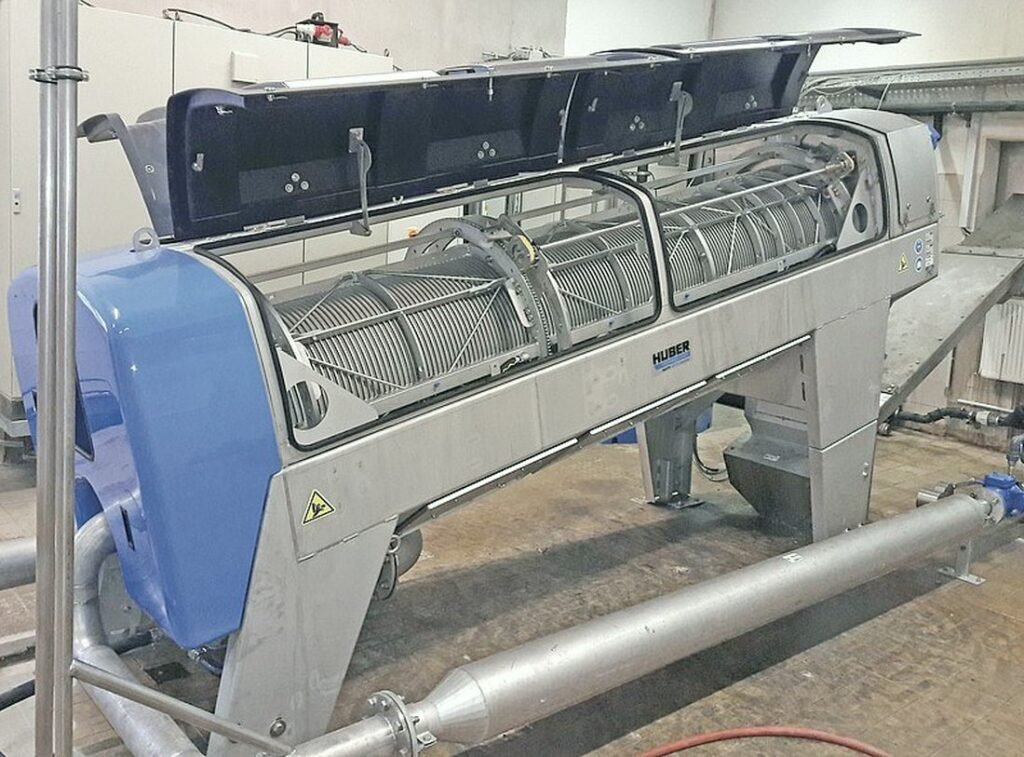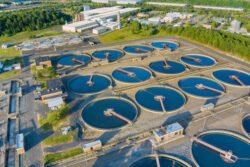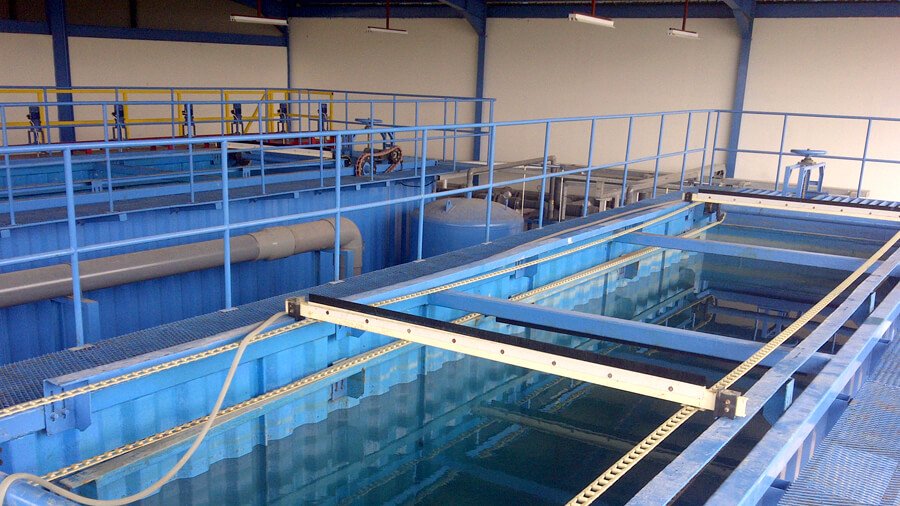Screw Presses in Wastewater Treatment: Efficiency and Applications

Screw presses play a crucial role in wastewater management, serving as an effective tool for the dewatering of sludges and slurries. These mechanical devices leverage a screw mechanism to apply pressure and separate solids from liquids. Their operation is relatively straightforward but highly dependent on specific variables such as screw speed, the design of the press, and the type of material being processed. Over time, the design and operation of screw presses have evolved, making them an integral part of modern wastewater treatment systems.
With their ability to produce dewatered material with a high solids concentration, screw presses offer a reliable method to reduce the volume and weight of wastewater biosolids. This process is not only essential for the efficient disposal and management of waste but also contributes to the environmental sustainability of wastewater treatment processes. Their application can be seen in a variety of treatment plants, and they continue to adapt to meet diverse industry needs, which span from municipal to industrial applications.
Key Takeaways
- Screw presses are critical for the dewatering process in wastewater management.
- They are characterized by their simplicity and efficiency in separating solids from liquids.
- Screw presses continue to evolve to meet the needs of modern wastewater treatment applications.
History and Development
Screw presses have a noted history in the field of wastewater treatment. Their development can be traced back to ancient times when Archimedes invented the screw pump. The Archimedean Screw—once used to lift water for irrigation or drainage—provided the design principles for modern screw presses.
In wastewater management, screw presses address the need for sludge dewatering. They operate on a simple mechanism: a screw rotates within a cylindrical screen, compressing the sludge and expelling water through the screen. Over time, this technology has evolved to become more efficient and reliable.
- Late 20th Century: Advancements in materials and mechanical design improved screw presses’ durability and efficiency.
- 21st Century: The integration of automation and control systems further optimized performance.
Screw presses offer several benefits in wastewater treatment, including low energy consumption, minimal operator intervention, and high-quality filtrate. They are widely applied in municipal and industrial wastewater facilities.
The evolution of screw presses represents the blending of classical engineering with modern technology, ensuring they remain vital components in wastewater treatment strategies. Their ongoing development is geared towards enhancing dewatering efficiency, reducing operational costs, and meeting increasingly stringent environmental regulations.
Design and Operation
Screw presses play a critical role in wastewater treatment by effectively separating solids from liquids. They are engineered to withstand the demanding conditions of sludge dewatering and abide by strict operational efficiencies.
Mechanical Components
Screw presses consist of a screw conveyor, enclosed in a screen basket, and a pneumatic counter-pressure cone. The screw conveyor, or auger, is the core element that drives the dewatering process, rotating to transport sludge through the press. The screen basket filters out solid content, which varies in micron size, to enable liquid separation. Critical to the press’s efficacy is the wedge zone, where initial filtration occurs, and the dewatering zone, where the sludge is pressed against the screen, allowing further drying.
Process Flow
At the start of the dewatering process, the sludge enters the inlet and is then conveyed by the screw through different zones of pressure. As the auger rotates, the space between its flights decreases, thereby squeezing the sludge and forcing water through the screen. This continuous process maintains a consistent output, resulting in a “cake” that has reduced moisture content. The design of the flow pathway ensures minimal obstruction and consistent movement of the material, avoiding any operational bottlenecks.
Control Systems
Control systems for screw presses are designed for automation and precision. They generally include feedback loops that monitor key operational parameters, such as torque, pressure, and rotational speed. These controls can adjust the press operation in real time, ensuring optimal performance and response to varying sludge characteristics. Such systems contribute to a consistent dewatered product and efficient operation, enabling wastewater treatment plants to maintain high standards of operation and meet regulatory requirements.
Applications in Wastewater Treatment
Screw presses play a vital role in managing solids during the treatment of wastewater. These devices are designed to efficiently reduce the water content of sludge, thereby minimizing its volume and handling costs.
Municipal Wastewater
In municipal wastewater treatment facilities, screw presses are employed to dewater sludge, which is a by-product of the treatment process. This mechanical dewatering strategy is essential for producing a dryer sludge cake. This cake can then be disposed of more cost-effectively or processed further for uses such as landfill cover or land application as a soil amendment. Efficiency in this process is critical, as highlighted in a US EPA fact sheet, which notes the ability of dewatering equipment to achieve high cake solids concentration.
Industrial Wastewater
In the context of industrial wastewater treatment, screw presses are utilized for their robust and effective dewatering capabilities. Industries that generate substantial amounts of wastewater, such as food processing, pharmaceuticals, or chemicals, rely on screw presses to separate solids from liquids. This separation allows for the recovery of valuable materials, reduces the volume of waste, and ensures that the resulting effluent meets regulatory standards for disposal or further usage.
Performance Metrics
When evaluating Screw Presses in Wastewater treatment applications, three specific performance metrics stand out: dewatering efficiency, operational reliability, and maintenance requirements. These metrics are crucial in determining the effectiveness and sustainability of a screw press within a wastewater management system.
Dewatering Efficiency
Dewatering Efficiency is a critical measure of a screw press’s ability to remove moisture from sludge. The metric is typically expressed as a percentage of water removed from the sludge, indicating the dryness level of the output cake. High dewatering efficiency can lead to reduced handling costs and improved downstream processing.
Operational Reliability
Operational Reliability refers to the consistency with which a screw press performs over time. A reliable screw press operates without significant downtime, maintains consistent dewatering efficacy, and withstands the harsh conditions often found in wastewater environments. Its reliability can be assessed by monitoring the frequency of unscheduled maintenance and the machine’s ability to continually meet performance standards.
Maintenance Requirements
Maintenance Requirements focus on the frequency, ease, and cost of maintaining a screw press. This includes routine inspections, cleaning, and the replacement of worn parts. Low maintenance requirements are indicative of a well-designed screw press that can lead to a lower total cost of ownership and less impact on operational uptime.
Advantages of Screw Presses
Screw presses are increasingly recognized in wastewater treatment for their efficiency and effectiveness. Low Operational Costs are a significant advantage; they are designed to operate with minimal supervision, reducing labor costs.
Energy Efficiency stands out as another key benefit. With their slow rotational speeds, screw presses consume less energy compared to centrifuges or belt presses.
Ease of Operation and Maintenance is apparent in their design simplicity. Fewer moving parts minimize the likelihood of mechanical failures and the need for repairs.
The High Solid Capture Rate ensures a drier cake, which can lead to further Cost Savings in handling and disposal.
- Performance Consistency: Achieves steady dewatering results.
- Quiet Operation: Low noise generation improves the workplace environment.
- Compact Design: Requires less floor space, a crucial factor for facilities with space constraints.
| Benefit DescriptionLow | |
|---|---|
| ow, Operational Costs | Minimal supervision is required. |
| Energy efficiency lowers | r energy consumption. |
| Maintenance | Fewer parts, less maintenance. |
| Solid Capture | Effective for drier solids. |
Moreover, screw presses demonstrate Versatility in processing various types of sludges, which is essential for plants that handle diverse waste streams.
They are also known for Odor Control, as they operate in an enclosed system, reducing odors typically associated with sludge processing.
Collectively, these advantages make screw presses an attractive option for wastewater treatment facilities aiming for cost-effective and reliable dewatering solutions.
Challenges and Limitations
Screw presses in wastewater treatment are crucial for sludge dewatering, but they confront several challenges and limitations. Here are the primary considerations:
- Capacity and Throughput: These devices have a finite capacity. High volumes of sludge necessitate larger or more screw presses, potentially increasing capital costs.
- Maintenance Needs: Screw presses require regular maintenance. Wearing parts, such as screw flights and screens, need periodic replacement.
- Operational Complexity: Operators require training to handle different types of sludge. Incorrect handling can lead to decreased efficiency and increased downtime.
Adaptability to Sludge Variability:
- Sensitivity: Performance can be sensitive to variations in sludge consistency and composition.
- Adjustment: Operators must adjust the screw press to account for these changes, which can be complex.
Energy Consumption:
- The process requires a significant amount of energy, impacting operational costs, particularly in regions with higher electricity prices.
Performance Limitations:
| Parameter | Impact |
|---|---|
| Dry Solids Content | Lower than other dewatering equipment |
| Polymer Use | Often requires more chemicals to achieve desired dryness level |
Odor and Noise Management: They can generate noise and odors, necessitating additional control measures that could increase operational costs and complexity.
While screw presses are effective for dewatering in wastewater treatment applications, these challenges and limitations must be considered to ensure that they operate efficiently and align with the specific needs and constraints of the treatment facility.
Case Studies
In the field of wastewater management, screw presses have been successfully implemented in various scenarios. A notable municipal wastewater treatment plant integrated screw presses for biosolids dewatering. The results from EPA’s overview show a significant reduction in sludge volume by up to 60%, facilitating easier handling and disposal.
| Facility | Capacity | Results |
|---|---|---|
| Municipal WTP | 30 MGD* | Sludge volume reduction by 60% |
| *(Million Gallons per Day) |
Another exemplary case involved a food processing facility that needed to manage high-strength waste. The employment of a screw press not only improved the dryness of the solids, enhancing compostability but also led to substantial operational cost savings.
- Highlight: Enhanced solids dryness for composting
- Benefit: Reduced operational costs
A study documented by the EPA explores how screw presses serve in anaerobic digestion processes. They successfully separate digestate into liquid and solid fractions, proving instrumental in optimizing the digestion system’s performance.
Anaerobic Digestion Facility
- Increased efficiency in digestate management
- Boosted biogas production
These cases demonstrate screw presses’ efficacy in diverse environments, underlining their flexibility and efficiency. The simplicity and reduced maintenance compared to other dewatering equipment make them an increasingly preferred choice in the wastewater sector.
Technological Advances
In the context of wastewater management, screw presses have undergone significant technological improvements. These advancements have allowed for more efficient solids separation and dewatering processes, which are critical in reducing the volume of sludge for disposal.
- Automation: Modern screw presses often integrate automated features such as self-adjusting screw speeds and pressure control, contributing to operational efficiency and consistent performance.
- Materials: The construction materials of screw presses have evolved. High-strength stainless steel and specialized alloys are now common, enhancing durability and corrosion resistance.
- Design Innovations: Innovative designs in screw profiles and screen geometries have improved the dewatering efficiency, maximizing output while minimizing energy consumption and cost.
Screw presses in wastewater treatment have embraced smart technology. Sensors capable of monitoring performance enable predictive maintenance, reducing downtime by alerting operators before issues arise. This proactive approach is instrumental in ensuring continuous operation in wastewater facilities.
Furthermore, manufacturers have refined filtration technology, which is evident in the improved filter screens that enhance particle retention and wastewater clarity. Such enhancements contribute to meeting stringent environmental discharge regulations.
| Feature | Benefit |
|---|---|
| Automated | Consistent operation, less manual oversight |
| Advanced Alloys | Longevity, resistance to wear and corrosion |
| Design | Higher throughput, better dewatering results |
| Smart Tech | Predictive maintenance, reduced downtimes |
Overall, these technological advances in screw presses have elevated not only their functional capabilities but also their role in sustainable wastewater management.
Market Trends
The market for screw presses in the wastewater industry is experiencing a shift due to technological advancements and increasing environmental regulations. The trend towards sustainability and renewable energy has bolstered the adoption of anaerobic digestion processes, where screw presses play an essential role in dewatering the sludge produced.
Recent trends indicate a steady increase in demand for more efficient and cost-effective sludge management solutions. This has led to:
- An emphasis on higher dry solids content to reduce the volume of sludge for disposal.
- Improved energy efficiency in operations, with manufacturers innovating to reduce the energy consumption of the screw presses.
- Enhancements in design to handle a wide range of sludge types, including those with higher fiber content.
Manufacturers are increasingly focusing on automation and control systems integration, allowing for more precise operations and alignment with modern smart wastewater treatment facilities.
Moreover, there’s a regional trend where emerging economies are investing heavily in wastewater infrastructure, presenting a growing market for screw presses. Specifically, the Asia-Pacific region shows significant growth potential due to its rapid urbanization and industrialization.
| Region | Trend |
|---|---|
| North America | Stable growth |
| Europe | Advanced tech adoption Asia |
| a-Pacific | Rapid market expansion |
In compliance with stricter waste management laws, wastewater treatment plants are gravitating towards technologies like screw presses that ensure regulatory adherence while also providing an ROI through resource recovery, such as biogas from the dewatered sludge.
Environmental and Regulatory Considerations
When discussing screw presses in wastewater treatment, environmental and regulatory factors play a significant role. These devices, designed to separate solids from liquids, must comply with environmental guidelines to ensure the protection of water quality and to contribute to sustainable waste management practices.
Regulatory Compliance: Operators must ensure screw presses meet the standards set by the U.S. Environmental Protection Agency (EPA) and other relevant entities. Regulations such as the Clean Water Act impact the permissible discharge of treated wastewater, necessitating efficient solid-liquid separation to minimize pollutants.
- Economic Benefits: The use of screw presses can lead to economic advantages due to reduced handling and disposal costs of dewatered waste.
- Greenhouse Gas Emissions: Proper treatment of organic waste with screw presses can reduce methane emissions, a powerful greenhouse gas, as noted by the EPA on anaerobic digestion.
Environmental Justice: There is an increasing focus on assessing the environmental justice implications of regulatory analysis, as articulated in recent EPA revisions. This implies a fair distribution of the environmental benefits of technologies like screw presses across all communities.
Technology Evolution: The ongoing development of screw presses must reflect advances in science and peer-reviewed guidelines to stay aligned with updated environmental priorities.
It is essential, therefore, for facilities employing screw presses to stay abreast of evolving regulations and to adapt operations accordingly to maintain compliance and support environmental sustainability.
Future Perspectives
The landscape of wastewater treatment is poised to evolve, with screw presses playing a pivotal role. They stand to benefit from technological innovations and an increasing focus on sustainability. The future of screw presses in wastewater management looks to:
- Enhance Automation: Developing more sophisticated control systems will improve efficiency and reduce the need for manual oversight.
- Optimize Design: There’s a move towards design refinement for better performance with lower energy consumption.
- Material Advances: Innovative materials could lead to longer-lasting, more resilient components with reduced maintenance needs.
- Expand Applications: Screw presses may find new applications in industries beyond traditional municipal wastewater treatment as more sectors seek sustainable solids separation solutions.
- Increase Efficiency: Research into optimizing the screw press dewatering process aims to extract dryer solids, which translates to reduced disposal costs.
| Expectation | Impact |
|---|---|
| Technological Advances | Improved operational efficiency |
| Material Development | Enhanced durability and lifespan |
| Environmental Regulations | Increased adoption and innovation |
The future underscores the importance of screw presses in achieving cost-effective and environmentally friendly wastewater treatment solutions. As regulations tighten and global water scarcity issues rise, their role is only expected to grow more prominent.
Frequently Asked Questions
How does a screw press operate in dewatering sludge within wastewater treatment facilities?
A screw press operates by rotating a screw within a cylindrical screen to separate water from sludge through applied pressure and filtration. As the sludge progresses along the screw, its volume is reduced, and water is forced out through the screen.
What are the key advantages of utilizing a screw press for sludge dewatering over other methods?
Screw presses offer several advantages including lower energy consumption, minimal odor emissions, and a smaller footprint. They are also known for their ease of operation and ability to handle a wide range of sludge types.
Can you outline the cost-benefit analysis of integrating screw presses into municipal wastewater management systems?
When integrating screw presses, cost considerations typically encompass construction, operation, and maintenance expenses, balanced against long-term savings from improved energy efficiency and reduced manpower requirements.
What maintenance requirements should be expected when operating screw presses in wastewater treatment plants?
Maintenance of screw presses primarily involves routine inspections, cleaning to prevent clogging or wear, and periodic replacement of parts such as the screw, brushes, and screen to ensure continued efficient operation.
Who are the leading manufacturers of screw presses for sludge dewatering, and how do their products differ?
Leading manufacturers of screw presses vary in design, technology, and capacity offerings. Their products differ in terms of performance, durability, and automation features tailored to diverse treatment facility needs.
In what ways can the efficiency of screw presses in wastewater treatment be optimized?
Efficiency can be optimized by regular maintenance, proper selection of screen sizes, adjusting operational parameters to match sludge characteristics, and implementing advanced controls for process optimization.


